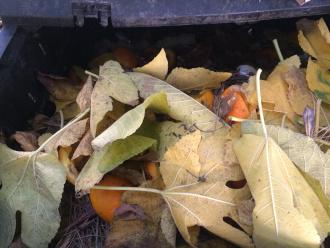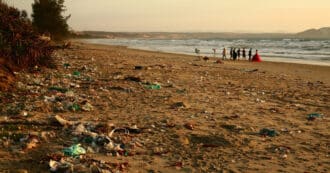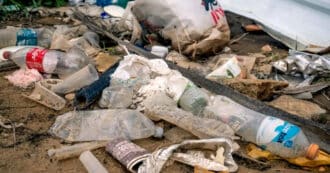By Matthew Mausner – Composting has become far more than just a “quirky” side practice of organic farmers and is now an advanced industry with a wide range of applications, while the benefits of composting to our environment are beyond question.
What is Composting?
Composting—the intentional use of natural decomposition and fermentation processes, to turn food waste, yard waste, and other organic material into useful soil and even fuel—has been refined and just now understood in ways that hold keys to our sustainable future.
Compost vs. Garbage dumps
Failure to compost
If you do not compost, waste creates unnecessary problems. The first is waste transport and disposal, which adds to landfills and garbage dumps, blights the landscape, exposes communities—most often low-income communities—to toxins, and greatly reduces the natural recycling of key elements and nutrients, such as phosphorus, back into the earth.
Consequences of not composting
The second problem is the use of toxic and expensive substitutes instead of naturally composted materials. This requires manufacturing, acquiring, and transporting such products as artificial fertilizers and chemical pesticides.
These cost more to produce, which drives up costs of use. They are less sustainable, exhausting topsoil and its fertility, and contaminating the environment, damaging countless organisms and food webs.
Methane gas
Third, waste will decompose whether we intentionally compost or not; the wrong kind of decomposition is anaerobic (no-oxygen), as often happens with compressed organic waste in landfills. Anaerobic decay emits a high proportion of methane gas, a greenhouse gas. Scientists predict that over the next 100 years, each ton of methane will heat the earth 30 times more than each ton of carbon dioxide.
Benefits of composting
The amount of trash generated by most human endeavors, from households to farms to factories, is daunting. But when trash is reconfigured as a tremendously useful resource for potential compost, the environmental equation can appear surprisingly positive. The benefits of composting, both by individuals and as a green industry, are immense and have only begun to be tapped.
Composting is natural
Composting is a fundamentally natural process throughout Earth’s ecosystem, involving both plants and animals. Organic materials, whether fallen leaves or trees, decomposing animals, seaweed, fungi, or another manner of organic waste will compost given the right range of humidity, local microorganisms, and other factors.
Ideal Composting
Ideally, the composted material will become nutrient-rich soil rapidly filled with new, natural growth, or in the context of human agriculture, will become the most fertile ground for the plants we cultivate. Before the last 100 years, composting was a necessity, not a luxury.
Composting at home
The simplest method of creating compost for a small home, farm, or garden is to create a compost pile. Food scraps, including everything from coffee grounds to eggshells, organic fodder and yard waste such as grass clippings, and a surprising variety of other organic matter, can be used in compost.
How to compost at home
Composting at home is done by layering organic waste, preferably with alternating and appropriately aerated layers of other organic materials, and providing the right balance of shade and sunlight.
This generates a decay, decomposition, and fermentation process that converts composting materials into a rich, beneficial material full of nutrients for fertilizer or even fully activated soil for a garden.
Advanced composting in history
Advanced compost methods can include technologies, innovations, and special ways of treating waste to compost more effectively, efficiently, or on a larger scale. In the pre-Colombian Amazon, people processed their food waste and other organic matter into uniquely dense soil “bricks” we call terra prieta, which was so remarkable, even today’s science has not replicated it.
Other ancient techniques like “night soil”—still used in some parts of the world— were practiced in east Asia, to generate rich soil and fertilizer from combinations of human, animal, and plant wastes.
Cleantech and Compost
New cleantech innovations are taking compost to new levels. New forms of “digester” or “bio-digester” machines can speed up, intensify, and optimize the conversion of organic material into useful, immediately available fuel and soil. Some of these machines are ten times as efficient as standard compost piles or earlier generations of digesters.
Municipal Waste
Municipal waste collection and disposal systems are increasingly aware of the need for environmental protection and responsibility. They see the cost/benefit of turning waste into compost via local conversion of huge trash loads into soil, fuel, fertilizers, and nutrients.
Reducing the cost of shipping waste to landfills, and of transporting and importing fertilizers and soil to every garden in their local jurisdiction, benefits all.
Noah’s Ark and Compost
God told Noah to make an Ark that had three levels, according to Genesis 6:16. The Talmud explains why. Humans were to be on the top deck, animals in the middle deck, and their manure held in the bottom. The Bible also says that one of Noah’s first actions after the flood was planting a vineyard.
The wisely accumulated manure stored on the bottom level likely helped Noah restart agriculture after the flood depleted the topsoil. . This may be the first Biblical reference to organic fertilizer. (See more in Eco Bible: Volume 1: An Ecological Commentary on Genesis and Exodus.)
Religious imperative to compost
If more houses of worship start to compost, that will have a big ripple effect. Does your house of worship serve as a positive example of mindful resource use, especially in regards to composting its organic waste? To compost shows, we value the whole life cycle, by wisely creating living soil from dying matter.
Conclusion
We can use modern words like “circular economies” to encourage a compost cycle, but it’s one of our oldest lessons. Proudly taking full responsibility for all the outputs and inputs of your life cycle embodies a spiritual and holistic approach that is part and parcel of religious traditions.
Interested in learning more? Check out our post on The Principles of Sustainable Development.









